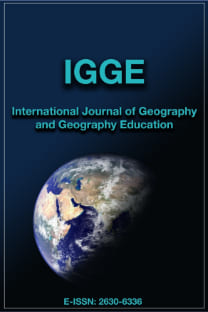COĞRAFİ BİLGİ SİSTEMLERİ’NİN (CBS) COĞRAFYA ÖĞRETİMİNDE KULLANIMININ ÖNEMİ VE GEREKLİLİĞİ
Coğrafya Öğretimi, Coğrafi Bilgi Teknolojileri, CBS (Coğrafi Bilgi Sistemleri)
-
Geography Education, Geographic Information Technologies, GIS(Geographic Information Systems),
___
- Aksoy, B. (2004). “Coğrafî Bilgi Sistemleri uygulamalarının öğretimi üzerine bir model”, Kastamonu Eğitim Dergisi, 12(1), s. 179190, Kastamonu.
- Aranoff, S. (1989). “Geographical Information Systems: A Management Perspective”, WDL Publications, Ottawa, Canada.
- Artvinli, E. (2009). “Coğrafya öğretmenlerinin Coğrafi Bilgi Sistemleri (CBS)’ne ilişkin yaklaşımları”, Balıkesir Üniversitesi Sosyal Bilimler Enstitüsü Dergisi, 12(22), Sayfa:40-57, Balıkesir.
- Aydoğmuş, M. Y. (2010). “Coğrafi Bilgi Sistemleri (CBS) Uygulamalarının Coğrafya Dersinde Öğrencilerin İlgi, Motivasyon ve Öğrenme Düzeylerine Etkisi”, Yayınlanmamış Yüksek Lisans Tezi, Marmara Üniversitesi Eğitim Bilimleri Enstitüsü, İstanbul.
- Baloğlu, Uğurlu, N. (2007). “Sosyal Bilgiler Dersinde Türkiye’nin Doğal Kaynakları Konusunun Coğrafi Bilgi Sistemleri ile Öğretiminin Öğrencilerin Tutum ve Başarısına Etkisi”, Yayımlanmamış Doktora Tezi, Gazi Üniversitesi Eğitim Bilimleri Enstitüsü, Ankara.
- Baloğlu, Uğurlu, N. (2008). “A new example for the use of ınformation technologies in education: Geographic Information System”, Ankara University Journal of Faculty of Educational Sciences, 41(2), Sayfa: 81-95, Ankara.
- Barker, F., ve Yeates, H. (1985). Introducing Computer Assested Learning, Prentice Hall International. London.
- Burrough, P. A. (1986). Principles Of Geographic Systems For Land Resources Assessment. Clarendon: Oxford.
- Cook, W.J. (1994). Breakthroughs that are Changing the Way We Live and Work. U. S. News and World Report, 2, s.46-60.
- Çukur, H. (2005). “Coğrafya Öğretiminin Hedefleri ve Coğrafi Bilgi Sistemleri”, D.E.Ü. Buca Eğitim Fakültesi, Eğitim Bilimleri Dergisi Sayı: 18, s.87-99, İzmir.
- Demirci, A. (2004). “Coğrafi Bilgi Sistemlerinin İlk ve Ortaöğretim Coğrafya Derslerinde Kullanılmasının Önemi ve Yöntemi: Fiziki Coğrafya; Deprem ve Volkanlar Konusu İle İlgili CBS Tabanlı Örnek Bir Ders Uygulaması”, Coğrafî Bilgi Sistemleri Bilişim Günleri, Fatih Üniversitesi, İstanbul.
- Demirci, A. (2007). “Coğrafi Bilgi Sistemlerinin Yükseköğretim Coğrafya Eğitimi İle Entegrasyonu: Başarılı Uygulamalar İçin Bir Yol Haritası”, Marmara Coğrafya Dergisi, 15(1), s. 207-228, İstanbul.
- Demirci, A. (2008). Öğretmenler İçin CBS: Coğrafi Bilgi Sistemleri, Fatih Üniversitesi Yayınları, İstanbul
- Doğanay, H., Zaman, S. (2002). “Orta Öğretim Coğrafya Eğitiminde Hedefler-Stratejiler ve Amaçlar”, Doğu Coğrafya Dergisi, 8, s.7-25, Erzurum.
- Dueker, K. (1979). Land resource information systems: a review of fifteen years experience. Geo-Processing, 1, s.105-28.
- Erdoğan H. (2009). “Ortaöğretim Coğrafya Derslerinde Doğal Afetler Konularının Coğrafi Bilgi Sistemleri Uygulamaları İle Öğretim”, Yayınlanmamış Doktora Tezi, Marmara Üniversitesi Eğitim Bilimleri Enstitüsü, İstanbul.
- Fitzpatrick, C., Maguıre, D. J. (2000). GIS in Schools: Infrastructure, Methodology and Role.
- Kawabata, M. (2010). “Multidisciplinary Cooperation in GIS Education: A Case Study of Us Colleges and Universities”. Journal of Geography in Higher Education, 34 (4), 493-509.
- Liu, Y., Bui, E. N., Chang, C-H., & Lossman, H. G. (2010). “PBL-GIS in Secondary Geography Education: Does It Result in HigherOrder Learning Outcomes?”. Journal of Geography, 109 (4), 1Moore, S., Brady, J., Bursek, J. & Francis, L. (2004). “An ocean of ıssues: Designing GIS-based lessons for secondary schools”, 4th Annual ESRI Education User Conference, 7-10 August, San Diego.
- Goodchild, M.F., Palladino, S.D. (1995). Geographic information systems as a tool in science and technology education. Speculations in Science and Technology, 18(4), s.278–286. Güngördü, E. (2002). Liselerde Coğrafya Dersi Öğretimi, Nobel Yayıncılık, Ankara.
- Heywood, I., Cornelius, S., Carver, S. (1998). An Introduction to Geographical Information Systems, Longman, , s.11-12, New York.
- İncekara, S., Karakuyu, M., Karaburun, A. (2009). “Ortaöğretim Coğrafya Derslerinde Yaparak Öğrenmeye Bir Örnek: Coğrafi Bilgi Sistemlerinin Proje Temelli Öğrenimde Kullanılması”, Elektronik Sosyal Bilimler Dergisi. 8 (30), s.305-322.
- MEB. (2005). Coğrafya Dersi Öğretim Programı, Milli Eğitim Bakanlığı, Talim ve Terbiye Kurulu Başkanlığı, Ankara.
- Özgen, N., Oban, R. (2008). “Yapılandırmacı Öğretimde Coğrafi Bilgi Sistemlerinin (CBS) Kullanımı Ve Yüksek Öğretim Kademelerindeki Coğrafya Derslerinde Uygulanabilirliği, I. Uluslararası Sosyal Bilimler Eğitimi Sempozyumu.
- Parker, H. D. (1988). The Unique Qualities Of Geographic Information System: A Commentary. Photgrammetric Engeneering And Remote Sensing, 54 (11), s.1547-49.
- Sağlam, A., Düzgün, H.S.B. ve Usul N., (2004). “Çanakkale Savaşlarına Farklı Bir Yaklaşım: Coğrafi Bilgi Sistemlerinde Gelibolu 1915”, Çanakkale Araştırmaları Türk Yıllığı - The Turkish Yearbook of Gallipoli Studies, Çanakkale Onsekiz Mart Üniversitesi Atatürk ve Çanakkale Savaşları Araştırma Merkezi, Sayı 2, Sayfa:117-133, Çanakkale.
- Sasaki, M. (2008). “GIS Education at Geographical Departments in Japanese Universities in Relation to the Japan Standard GIS Core Curriculum”. International Research in Geographical and Environmental Education, 17 (4), 298-301.
- Şahin, S. & Gençtürk, E. (2007). Kuram ve Uygulamada Coğrafya Eğitimi, Coğrafya Eğitimi ve Bilgi İletişim Teknolojileri, Gazi Kitabevi, s.175-222, Ankara.
- Şimşek, N.(2008). Sosyal Bilgiler dersinde Coğrafi Bilgi Sistemleri (CBS) teknolojisinin kullanılması. Kastamonu Eğitim Dergisi, 16(1), Sayfa:191-198, Kastamonu.
- Tschirner, S. ve O'Brien, M. (2006). “TEGIS –Technology in Education with GIS 'Schools in the Digital Age'”, Presentation at the National Conference 2006 of the Computer Education Society of Ireland CESI.
- Tuna, F., (2008). Ortaöğretim Coğrafya Derslerinde Proje Tabanlı Öğrenimi Desteklemek Amacı İle Coğrafi Bilgi Sistemlerinden (CBS) Yararlanma, Yayımlanmamış Doktora Tezi, Marmara Üniversitesi Eğitim Bilimleri Enstitüsü, İstanbul.
- Uçar D., (2001). “Kadastro Amaçlı ve Topografik Amaçlı Ülke Bilgi Sistemlerinin Entegrasyonu”, 8. Türkiye Harita Bilimsel ve Teknik Kurultayı, Ankara.
- Yomralıoğlu, T., (2000). “Coğrafi Bilgi Sistemleri Temel Kavramlar ve Uygulamalar”, Akademi Kitabevi, 2. Baskı. http:/www.mutasyon.net E.T: 10.09.2013 http:/www.coastlearn.org E.T: 30.09.2013 http://digitalscholarship.emory.edu/ E.T: 04.10.2013
- Yayın Aralığı: Yılda 3 Sayı
- Başlangıç: 1996
- Yayıncı: Marmara Üniversitesi
KÜLTÜREL MİRAS KAYNAĞI OLARAK KÖPRÜBAŞI İLÇESİNDE (TRABZON) GELENEKSEL TAHTA KAŞIK ÜRETİMİ
MODA-CADDEBOSTAN (KADIKÖY) ARASI KIYI ALANINDAKİ DEĞİŞİMİN İNCELENMESİ
Nuriye GARİPAĞAOĞLU, Sibel ÖZCAN, Murat UZUN
COĞRAFİ BİLGİ SİSTEMLERİ’NİN (CBS) COĞRAFYA ÖĞRETİMİNDE KULLANIMININ ÖNEMİ VE GEREKLİLİĞİ
AFRİKA ÜLKELERİNİN KÂĞIT PARALARINDAKİ COĞRAFİ UNSURLAR
BEŞERİ COĞRAFYA PERSPEKTİFİNDEN TATARİSTAN CUMHURİYETİ
Emin ATASOY, Vedat ÇALIŞKAN, Elena GALAİ
COĞRAFYA ÖĞRETMENLİĞİ YÜKSEK LİSANS PROGRAMI ÖĞRENCİLERİNİN YÜKSEK LİSANSTAN BEKLENTİLERİ
COĞRAFİ ORTAM VE KENT FİZYOLOJİSİ İLİŞKİLERİ: XIX. YÜZYIL KİLİS ŞEHRİ ÖRNEĞİ
COĞRAFYA LİSANS ÖĞRENCİLERİNİN MEZUNİYET SONRASI KARİYER PLANLARINA İLİŞKİN GÖRÜŞLERİ
